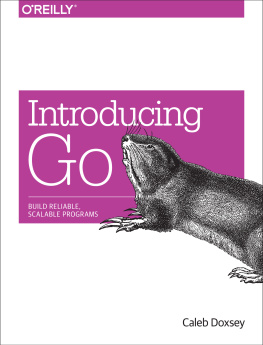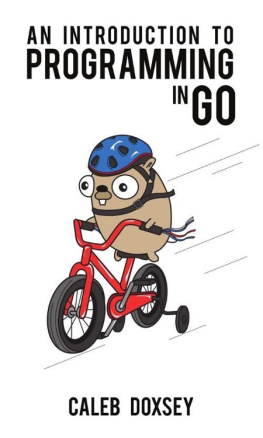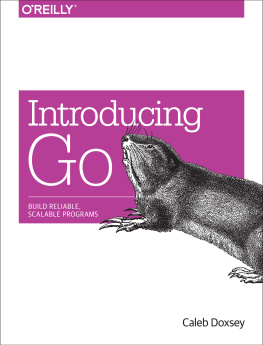Caleb Doxsey - Introducing Go: Build Reliable, Scalable Programs
Here you can read online Caleb Doxsey - Introducing Go: Build Reliable, Scalable Programs full text of the book (entire story) in english for free. Download pdf and epub, get meaning, cover and reviews about this ebook. year: 2016, publisher: OReilly Media, genre: Computer. Description of the work, (preface) as well as reviews are available. Best literature library LitArk.com created for fans of good reading and offers a wide selection of genres:
Romance novel
Science fiction
Adventure
Detective
Science
History
Home and family
Prose
Art
Politics
Computer
Non-fiction
Religion
Business
Children
Humor
Choose a favorite category and find really read worthwhile books. Enjoy immersion in the world of imagination, feel the emotions of the characters or learn something new for yourself, make an fascinating discovery.
- Book:Introducing Go: Build Reliable, Scalable Programs
- Author:
- Publisher:OReilly Media
- Genre:
- Year:2016
- Rating:5 / 5
- Favourites:Add to favourites
- Your mark:
Introducing Go: Build Reliable, Scalable Programs: summary, description and annotation
We offer to read an annotation, description, summary or preface (depends on what the author of the book "Introducing Go: Build Reliable, Scalable Programs" wrote himself). If you haven't found the necessary information about the book — write in the comments, we will try to find it.
Perfect for beginners familiar with programming basics, this hands-on guide provides an easy introduction to Go, the general-purpose programming language from Google. Author Caleb Doxsey covers the languages core features with step-by-step instructions and exercises in each chapter to help you practice what you learn.
Go is a general-purpose programming language with a clean syntax and advanced features, including concurrency. This book provides the one-on-one support you need to get started with the language, with short, easily digestible chapters that build on one another. By the time you finish this book, not only will you be able to write real Go programs, youll be ready to tackle advanced techniques.
- Jump into Go basics, including data types, variables, and control structures
- Learn complex types, such as slices, functions, structs, and interfaces
- Explore Gos core library and learn how to create your own package
- Write tests for your code by using the languages go test program
- Learn how to run programs concurrently with goroutines and channels
- Get suggestions to help you master the craft of programming
Caleb Doxsey: author's other books
Who wrote Introducing Go: Build Reliable, Scalable Programs? Find out the surname, the name of the author of the book and a list of all author's works by series.










![Mark Lassoff [Mark Lassoff] - Java Programming for Beginners](/uploads/posts/book/119362/thumbs/mark-lassoff-mark-lassoff-java-programming-for.jpg)